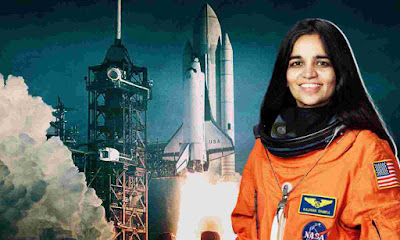Today (February 1, 2003) is the anniversary of Kalpana Chawla, the first Indian woman to go into space.

Kalpana Chawla was born on July 1, 1961, in Colonel, Haryana, India, to a
Punjabi family, the daughter of Banaras Lal Chawla and Sanyokita Devi. He had
two sisters, Sunita and Deepa, and a brother, Sanjay. Kalpana Chawla started
her primary education at a government school in Karnal. India's foremost pilot
and industry giant JRD Kalpana Chawla has been interested in flying since she
saw Tata. He received his Bachelor's degree in Aviation from the Punjab College
of Engineering, Chandigarh in 1982. He later received a master's degree in
aerospace engineering from the University of Texas in the United States in
1984. He received his second master's degree from the University of Colorado at
Boulder in 1986, and his doctorate in aerospace engineering in 1988.

In 1988, he co-founded CFD research at V / STOL, where he served as vice
president of "Osset Method Inc." at NASA's Ames Laboratory. Not only was
he certified to teach flying and gliding, but he was also licensed to drive. He
also received a Technician Class amateur radio license with the FKT5AC label.
He joined the NASA astronaut training team in 1995 and was selected to travel
on the "Colombian space shuttle SDS-87" for the next two years.
During this voyage in 1997, he successfully returned to Earth after a record
372 hours from space. In 1984, she became the first Indian woman to go into
space after Rakesh Sharma aboard a Soviet spacecraft. During the STS-87,
Winston Scott and Takao Toy were responsible for controlling a defective
satellite, the Spartan, which was in space. After five months of thorough
investigation and testing, NASA found bugs in the software, the flight crew's
procedures and ground controls.

After STS-87, Kalpana was hired by NASA as a technician in the space
office. His colleagues also presented him with an award in recognition of his
work. Kalpana Chawla, who successfully completed her first space mission, is
preparing for her second mission in the next five years. The trip, which was
scheduled to take place in 2000 and 2002, was delayed due to a variety of
technical glitches. Then, on January 16, 2003, the Columbia spacecraft STS-107
was launched from the Kennedy Station in the United States for space
exploration. Seven people, including Kalpana Chawla, a woman of Indian descent,
travelled in it. During the voyage, Chawla was responsible for micro-gravity
tests. To this end, his team monitored the Earth and space and conducted 80
experiments. Among them is the development of space technology related to the
health and safety of astronauts and the development of various experiments.


The spacecraft, which successfully returned to Earth after a 16-day
mission, exploded in Texas airspace. Seven precious astronauts were killed,
including Kalpana Chawla. Kalpana came to India with her husband in 1991-1992
to celebrate the New Year with her family. This was his final visit. Posthumous
awards include the Congressional Space Medal of Honor, NASA's Space Flight
Medal, and the NASA Distinguished Service Medal, presented by the U.S. Congress
in his memory. Countless places are named after Kalpana Chawla. As well as the
grant is given in his name. The Indian Students' Association (ISA) of the
University of Texas at El Paso has established a 'Kalpana Chawla Memorial
Scholarship' for commemorative university graduates.

An asteroid numbered 51826, discovered on July 19, 2001, is named after
Kalpana Chawla. The temperature of this planet is 159k. Its average speed is
16.5 kilometres per second. The Naval Air Station in Maryland has renamed its
Military Housing Board at Poducent River Columbia Colony. There is also a
street called Chawla way. 74th Street in Jackson Heights, Queens, New York,
USA, was renamed the Kalpana Chawla Way. The Haryana government has named the
Kalpana Chawla Planetarium, built at Jyotisar in Kurukshetra. NASA has
dedicated a state-of-the-art computer in memory of Kalpana. The Government of
Karnataka presents the Kalpana Chawla Award in 2004 to encourage young female
scientists. Asteroid 51826 Kalpana Chawla in Magazine and Novel - One of the
seven acclaimed magazines named after the Colombian space crew. Novelist Peter
David named the character Chawla in his novel Star Trek, The Next Generation:
Before Dizoner, and named the character Chawla to the spacecraft that appears
in the novel.


Kalpana Chawla, the first Indian record holder to go into space, was
launched on February 1, 2003, at the age of 40. Kalpana Chawla was educated in a
normal school and made her dreams come true to the amazement of many. It is no
exaggeration to say that she was a world-famous figure for India, exemplifying
the pride of womanhood. We also admire the heroine who made it clear to the
world that ‘success is guaranteed if Vida works hard and wholeheartedly to make
dreams come true.
Source By: Wikipedia
Information: Dr. P. Ramesh, Assistant Professor of Physics, Nehru Memorial
College, Puthanampatti, Trichy.
Get information like this
https://t.me/joinchat/jpqj3jQLN51kYTk9
Join Telegram Group.
https://chat.whatsapp.com/FisIzCe4Br2CRgxAiicUnf
Join WhatsApp Group
Thanks.
Also, Read
🛑👍 CSIR-NET Physics Materials and Problems
🛑📕 21 GB and Hundreds of Physics E-Books Collection.
🛑🛥️ How does an Electric Motor work? (DC Motor).
🛑🤹♂️ Science Academies' Summer Research Fellowship Programme for Students and Teachers 2022.
🛑🔌 How does a Transformer work - Working Principle electrical engineering.
🛑🎙️ Transistors Explained - How transistors work.
🛑🔥⚡ How Thermocouples Work - basic working principle.
🛑🔌 Voltage Explained - What is Voltage? Basic electricity potential difference
🛑🔌 What is CURRENT– electric current explained, electricity basics.


.jpg)
No comments:
Post a Comment